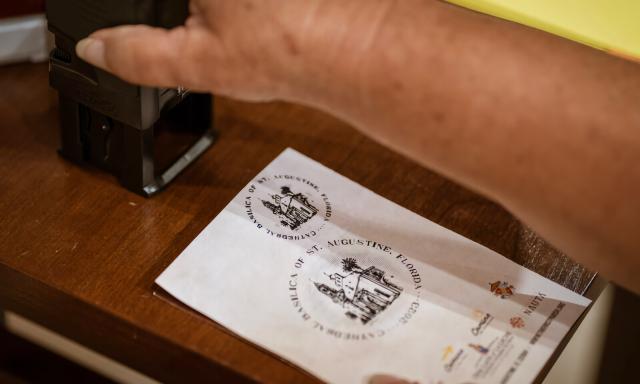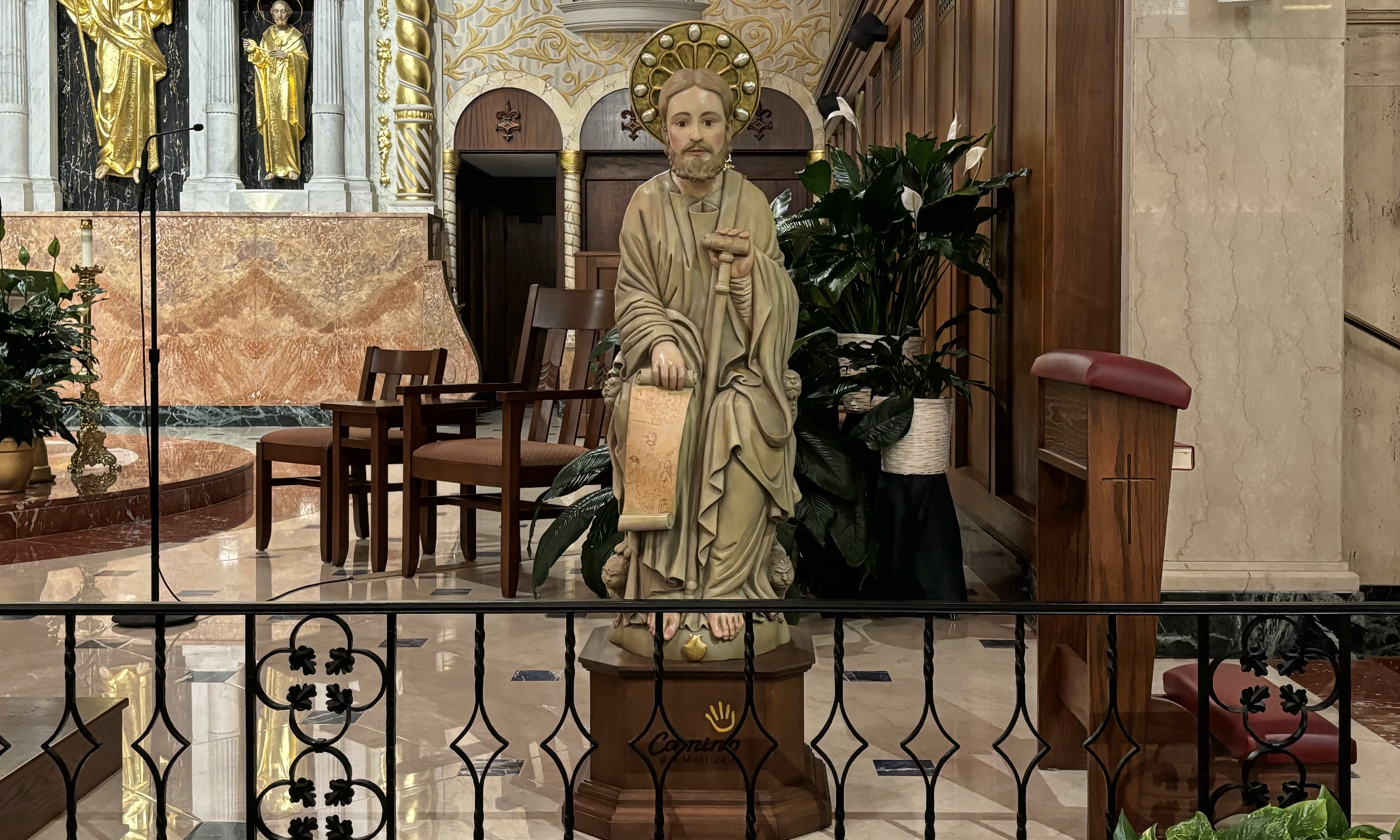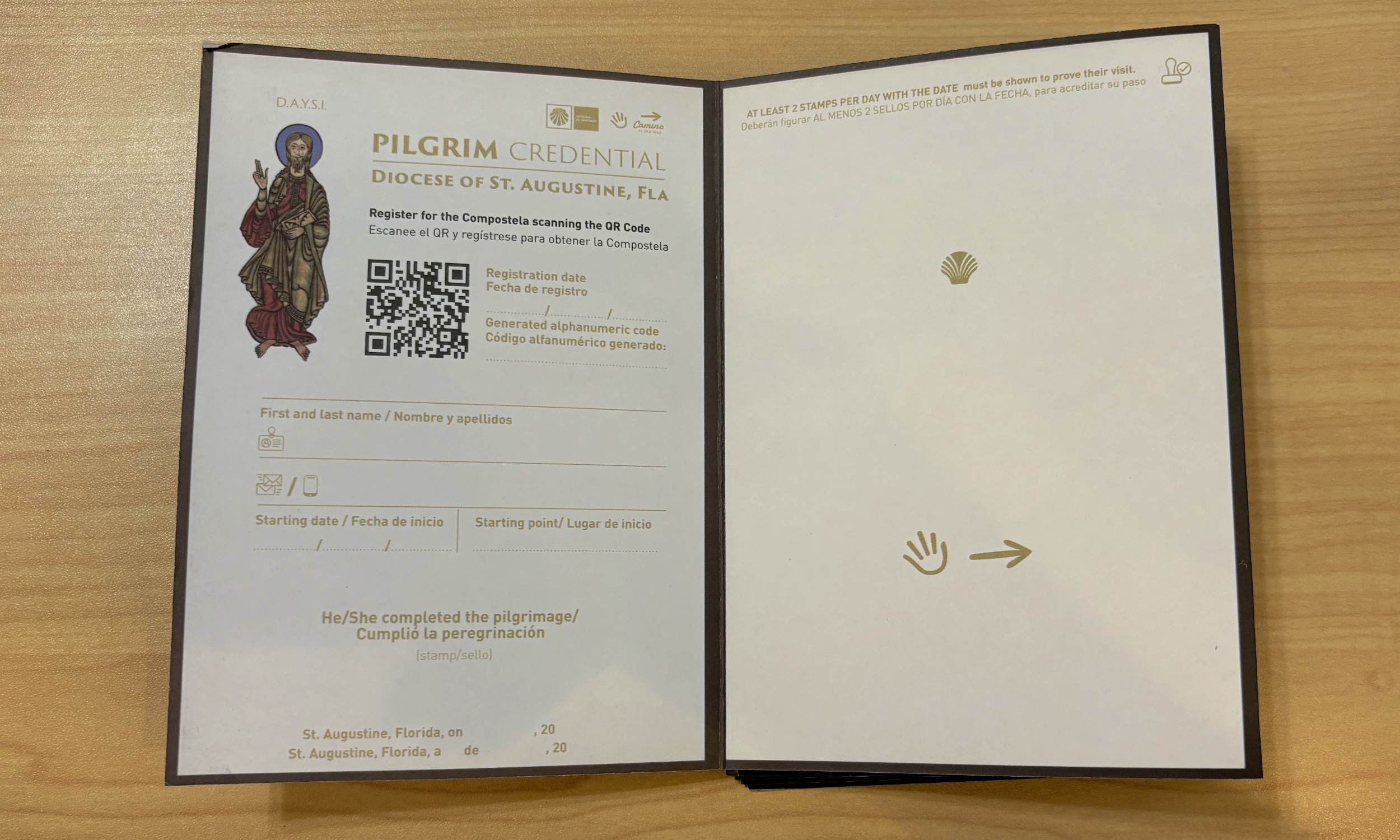Camino de las Américas — on the First Coast
In Europe, the Camino de Santiago offers a unique guided, or self-guided, walking tour along several routes from cities in France, Portugal, and Spain, all ending at the magnificent Santiago de Compostela in Galicia, Spain, where the body of St. James the Apostle is buried.
Catholics on a pilgrimage and people who enjoy contemplation, walking, and culture, have “walked their Camino” in Italy, France, Portugal, and Spain. Now, pilgrims and adventurers can start their Camino from the Cathedral Basilica of St. Augustine, before flying or sailing to Europe to continue their Camino on one of the other routes.
To be certified as completing a pilgrimage, each person must walk at least 100 kilometers (roughly 60 miles) on foot. Documentation takes the form of special passports for the Camino de Santiago, with stamps issued by churches and sites along the route. Hikers and pilgrims starting In St. Johns County can purchase passports at the First Coast Cultural Center in Ponte Vedra and the Cathedral Basilica of St. Augustine.
The Camino de las Américas First Coast Route
The entire First Coast Camino is a 50-kilometer or 30-mile route from Jacksonville Beach to the Cathedral Basilica, equaling half of the minimum 100 kilometers of required distance. All but the first two stops are in St. Johns County. Just as in Spain, the stops on the First Coast include museums, monuments, and archaeological sites, providing more information about the culture, history, and natural beauty of the region.
This route begins on Jacksonville Beach and continues south on A1A. Some segments will be on the beach, others on a sidewalk, and a relatively long distance will be along the bike lane of A1A from Ponte Vedra to Vilano Beach. There are seven stops along this route, three of which have stamps.

The First Coast Camino
The route starts on Jacksonville Beach and ends at the Cathedral Basilica in St. Augustine.
- Jacksonville Beach Pier
- St. Paul’s Catholic Church, 224 North 5th Street, Jacksonville
- Our Lady Star of the Sea Catholic Church, 607 Ponte Vedra Blvd., Ponte Vedra Beach
- First Coast Cultural Center, 6000 B Sawgrass Village Drive, Ponte Vedra Beach. Here, walkers and pilgrims may purchase passports and get a stamp for that location.
- Mickler’s Beach, 1111 Ponte Vedra Boulevard, Ponte Vedra Beach
- Guana Tolomato Matanzas National Estuarine Research Reserve, 505 Guana River Road, #6527, Ponte Vedra Beach
- National Shrine of Our Lady of La Leche, 101 San Marco Avenue, St. Augustine. There is a stamp at this location.
- Cathedral Basilica, 38 Cathedral Place, St. Augustine. Here, walkers and pilgrims may purchase passports and get a Cathedral stamp. The Cathedral Basilica Bell Tower Gift Shop sells Camino passports and will add the stamped credential for the walk. The gift shop is open from 10:00 a.m. to 4:30 p.m. The statue of St. James can be viewed in the Basilica’s sanctuary. Pilgrims and tourists can have their credentials or passports stamped in the visitor booth in the Cathedral’s west courtyard, from 9:00 a.m. to 5:00 p.m.
The St. Augustine Camino
Pilgrims and walkers who want to start in St. Augustine without walking as far on this continent can explore the National Shrine of Our Lady of La Leche, and then walk to the Cathedral for a stamp.
Information and App
The First Coast Cultural Center in Ponte Vedra has worked closely with church officials from the Camino de Santiago to help travelers and pilgrims begin their Camino journey in America.
In addition to selling the passports for $10.00, they have collaborated to create an App, “Camino Is The Way,” that describes the different routes on the First Coast. Walkers and pilgrims can also use the app’s GPS link to record their journey. Search for Camino is the Way in your app store. Once you have downloaded the app, you can register and manage your official QR Code in the credential section of the app, just as official Catedral de Santiago pilgrims do.
History of the Camino de Santiago
For hundreds of years, between the 800s and 1500s, Catholic pilgrims would walk the Camino de Santiago along overland routes from their respective parish to the magnificent Cathedral of Santiago de Compostela in Galicia, Spain, where the body of St. James the Apostle is buried. These walks may have been a form of penance and many believed completing the Camino de Santiago reduced their time in purgatory.
In the 1990s, Catholic Camino enthusiasts and several tourist boards created programs and promotions that resulted in new interest in the Camino de Santiago (The Way of St. James) and they chose to highlight several routes from France, Portugal, and other parts of Spain. Now, the Camino de Santiago promotes cultural exchange and understanding and is traveled by those of many faiths. In 1993, 100,000 people were recorded traveling the route and it was declared a UNESCO World Heritage Site.
Later, the Catholic Church extended the Camino to the Americas, creating a spiritual and cultural path from Santiago, Chile, to St. Augustine, Florida.
For more than a decade, community leaders in St. Augustine worked to bring the Camino to our city from Avilés, Spain’s Pedro Menendez. In 2022, a statue of St. James was presented to the Basilica and installed in the sanctuary. Funded with contributions from organizations in Spain and the First Coast, artist Juan Vega carved the statue in cedar. It is now permanently on display in the west courtyard of the Basilica.
The Nauta Institute in collaboration with the Cathedral Alliance, encouraged and promoted the First Coast Camino. The organizations, of which the Cathedral Basilica is a member, work to unite different cultures and religions, promoting tolerance and mutual respect. The Cathedral Basilica of St. Augustine is the starting point for pilgrims departing for the Camino de Santiago de Compostela (The Way of St. James in Spain) and the ending of the Camino del Mestizaje of the Americas.
Jessica Larson took the photo of the statue procession.




